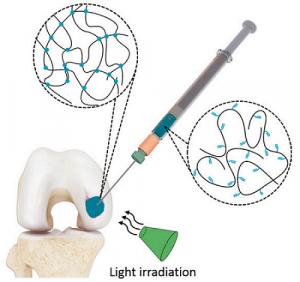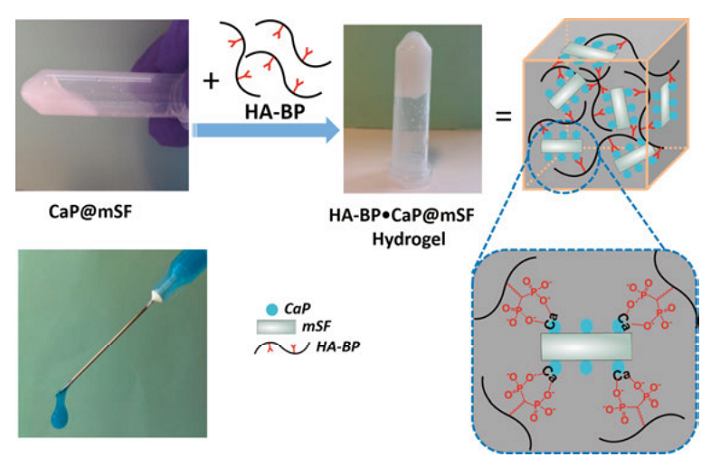It seems safe to say that self-healing materials are extremely fascinating. The 3D printing world has shown them increasing interest lately, with potential applications including electronic devices and cartilage replacements. Last summer, a team of researchers at the University of Manitoba created a new method of designing conductive, 3D printable, self-healing hydrogel materials to make them mechanically stable, which involved both physical and chemical cross-linking.

Schematic of the injectable “A+B” hydrogels using double barrel syringe, which are cross-linked by covalent bonds during or after injection.
3D hydrogels are hydrophilic polymeric networks cross-linked by either chemical covalent bonds, physical interactions, or a combination of the two. Because of the crosslinks between polymer chains and their hydrophilic nature, hydrogels can actually swell up to a hundred times, or even a thousand, of their dried mass without needing to be dissolved in water.
While hydrogels used to be pre-prepared and implanted into target sites within the human body during surgical procedures, they can now be easily injected from a syringe through a fine needle, making the material perfect for biomedical applications.
 According to a dissertation, titled “Injectable Composite Hydrogels Based on Metal-Ligand Assembly for Biomedical Applications,” by Liyang Shi with Uppsala University in Sweden, injectable hydrogels are very useful in developing minimally invasive surgical procedures, as they “avoid damage of surrounding tissues during implantation surgery” and can easily fill defects with complex shapes in situ. In addition, it’s not difficult to 3D print injectable hydrogels so they form more advanced, customized morphology hydrogels by automating their extrusion from a syringe and programming the movement in a CAD file.
According to a dissertation, titled “Injectable Composite Hydrogels Based on Metal-Ligand Assembly for Biomedical Applications,” by Liyang Shi with Uppsala University in Sweden, injectable hydrogels are very useful in developing minimally invasive surgical procedures, as they “avoid damage of surrounding tissues during implantation surgery” and can easily fill defects with complex shapes in situ. In addition, it’s not difficult to 3D print injectable hydrogels so they form more advanced, customized morphology hydrogels by automating their extrusion from a syringe and programming the movement in a CAD file.
The abstract of Shi’s dissertation reads, “This thesis presents new strategies to construct injectable hydrogels and their various biomedical applications, such as 3D printing, regenerative medicine and drug delivery. These hydrogels cross-linked by dynamic metal-ligand coordination bonds exhibit shear-thinning and selfhealing properties, resulting in the unlimited time window for injection. Compared with nondynamic networks based on chemically reactive liquid polymer precursors that forms covalent bond during and/or post-injection, our injectable hydrogels with dynamic cross-linkages can be injected from an already cross-linked hydrogel state.”

Overview of various HA-BP based hydrogels presented in this thesis and biomedical applications for which the hydrogels were utilized. Derivatives HA-BP (i), HA-BP(ii), and HA-BP(iii) represent three different types of attachment of BP moieties to HA backbone.
Shi used hyaluronic acid (HA) as the polymer, because it is both biocompatible and biodegradable. First, it was modified with bisphosphonate (BP) as chelating (heterocyclic ring-shaped chemical compound) ligand.
“In the first part of this thesis, I presented the different chemical approaches to synthesize BP-modified HA (HA-BP) derivatives as well as HA derivatives dually modified with BP and acrylamide (Am) groups (Am-HA-BP). The structures of HA-BP derivatives were confirmed by NMR characterizations, e.g. by the peak at 2.18 ppm for methylene protons adjacent to the bridging carbon of BP in 1H-NMR spectrum and phosphorus peak at 18.27 ppm in 31P-NMR spectrum, respectively,” Shi continued. “In the next part, the hydrogels were constructed by simple mixing of HA-BP or Am-HA-BP solution with Ca2+ ions (Paper I), Ag+ ions (Paper II), calcium phosphonate coated silk microfibers (CaP@mSF) (Paper III), and magnesium silicate (MgSiO3) nanoparticles (Paper IV).”

The hydrogel precursors consisting of the polymer chain containing UV cross-linkable groups are ejected out from syringe at liquids which is followed by polymerization cross-linked in defect area using light.
The hydrogels created during the experiment “exhibited dynamic features” like shear-thinning and self-healing properties. Shi applied four types of hydrogels based in HA-BP to different biomedical applications, including 3D printing, wound healing, bone regeneration, and controlled delivery of anti-cancer drugs.
“Additionally, reversible coordination hydrogels were demonstrated to be further covalently cross-linked by UV light to form a secondary cross-linkage, allowing an increase of the strength and modulus of the hydrogels,” Shi wrote.” In the last part of this thesis, biomedical applications of these hydrogels were presented.”
Shi used a homemade 3D printer to extrude Am-HA-BP•Ca2+ hydrogel, before using UV radiation to create a 3D tube-like construct with multiple layers. Using a rat model with full-thickness skin defects, HA-BP•Ag+hydrogel was able to increase the wound healing process, along with the thickness of the rat’s new epidermal layer.
In addition, double cross-linked Am-HA-BP•CaP@mSF hydrogel was able to induce new bone to form, without having to add any biological factors or cells. Finally, the hydrogel loaded with anti-cancer drugs was prepared by mixing HA-BP solution with drug-loaded MgSiO3 nanoparticles; the released particles from this combination “were shown to be taken up by cancer cells to induce a toxic response.”

Preparation process and injectable properties of HA-BP•CaP@mSF hydrogel. The hydrogel is formed by addition HA-BP polymer binder to CaP@mSF dispersion, and cross-linking by the coordination bonds of BP groups on HA backbones and CaP on the microfibers. For visualization, alcian blue as a dye was dissolved in the hydrogel.
“In summary, this thesis presents metal-ligand coordination chemical strategies to build injectable hydrogels with dynamic cross-linking resulting in time-independent injection behavior. These hydrogels open new possibilities for use in biomedical areas,” Shi concluded.
Discuss this research and other 3D printing topics at 3DPrintBoard.com or share your thoughts below.
Subscribe to Our Email Newsletter
Stay up-to-date on all the latest news from the 3D printing industry and receive information and offers from third party vendors.
You May Also Like
Air Force Awards Fortius Metals $1.25M to Qualify 3D Printing Wire for Hypersonic Applications
AFWERX, part of the US Air Force Research Laboratory (AFRL), awarded a Direct-to-Phase II Small Business Innovation Research (SBIR) contract worth $1.25 million to Colorado’s Fortius Metals, to accelerate qualification...
US Air Force Awards JuggerBot $4M for Large-format Hybrid 3D Printing
Large-format 3D printer manufacturer JuggerBot has received a $4 million grant to develop a large format 3D printer, courtesy of the Under Secretary of Defense, Research and Engineering Manufacturing Technology...
Where Have All AM’s Unicorns Gone?
In the rapidly evolving world of 3D printing, startups valued at over a billion dollars, known as unicorns, once seemed as fantastical as the mythical creatures themselves. While a few...
How My Childhood Fascination with Planes Led to Investing in 3D Printing
My fascination with aerospace started young, and I started studying planes–identifying them in the sky and learning everything I could about how they work. Fast forward to my first week...































